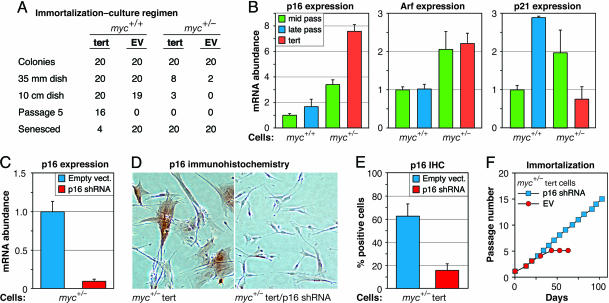Fig. 1.
Up-regulation of p16 in c-myc+/− cells prevents hTERT-mediated immortalization. (A) Introduction of hTERT into c-myc+/+ and c-myc+/− cells. Cells were infected with hTERT-expressing (tert) and empty (EV) retrovirus vectors, diluted, and selected with drug. Twenty individual founder colonies for each cell strain/vector combination were harvested with cloning rings and expanded as indicated. The number of colonies (clones) that could be passed to the next step is indicated. For tert-infected c-myc+/− cells, although eight colonies could be passed out of 35-mm dishes and three of these could be passed out of 10-cm dishes, none could be propagated up to the fifth passage. For EV-infected c-myc+/− cells, only two colonies could be passed out of 35-mm dishes, and neither of these could be passed out of 10-cm dishes. In contrast, tert elicited robust immortalization of c-myc+/+ cells, with only 4 out of 20 clones failing to undergo long-term expansion. A single representative experiment is shown. The same results were obtained with two different hTERT vectors on at least three separate occasions. (B) p21 (Right), p16 (Left), and Arf (Center) mRNA expression in mid- and late-passage c-myc+/+ cells and in mid-passage and hTERT-expressing late-passage c-myc+/− cells analyzed by qPCR. (C and D) Knockdown of p16 mRNA levels by retroviral expression of stable p16 shRNA analyzed by qPCR of pooled drug-selected cells (C) and by IHC detection of p16 protein in single cells (D). (E) Quantification of data shown in D. (F) Knockdown of p16 expression in hTERT-expressing c-myc+/− cells allows immortalization. Passage number was arbitrarily reset to one when cells were passaged out of drug selection.

